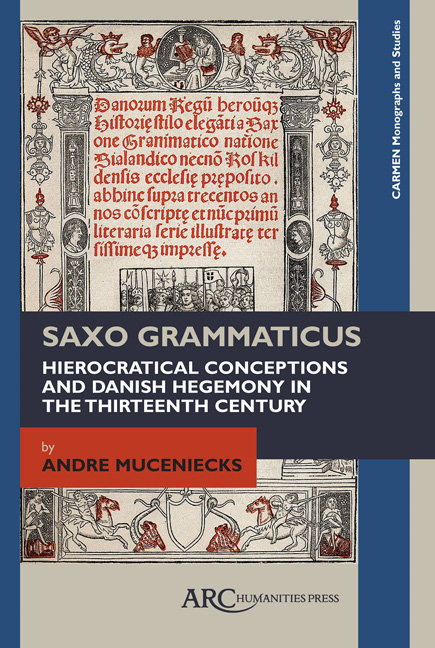Book contents
- Frontmatter
- Contents
- List of Illustrations
- Acknowledgements
- Foreword
- Preface
- Chapter 1 Denmark and the Baltic in the Thirteenth Century
- Chapter 2 The Work
- Chapter 3 Political Conceptions
- Chapter 4 Euhemerism and the East in Saxo Grammaticus
- Chapter 5 Virtues and Values in Saxo Grammaticus: The Four Cardinal Virtues
- Chapter 6 The Thematic of the Counsellor
- Conclusion
- Appendix 1 List of the Kings in Books I–VIII of the Gesta Danorum
- Appendix 2 Rulers and Archbishops of Denmark in Relation to Events in the Baltic, the Empire, and the Papacy
- Appendix 3 Genealogy of the Valdemarian Kings
- Bibliography
- Index of Persons
- Index of Places and Peoples
- Index of Authors and Primary Sources
- Index of Subjects
Conclusion
Published online by Cambridge University Press: 15 January 2021
- Frontmatter
- Contents
- List of Illustrations
- Acknowledgements
- Foreword
- Preface
- Chapter 1 Denmark and the Baltic in the Thirteenth Century
- Chapter 2 The Work
- Chapter 3 Political Conceptions
- Chapter 4 Euhemerism and the East in Saxo Grammaticus
- Chapter 5 Virtues and Values in Saxo Grammaticus: The Four Cardinal Virtues
- Chapter 6 The Thematic of the Counsellor
- Conclusion
- Appendix 1 List of the Kings in Books I–VIII of the Gesta Danorum
- Appendix 2 Rulers and Archbishops of Denmark in Relation to Events in the Baltic, the Empire, and the Papacy
- Appendix 3 Genealogy of the Valdemarian Kings
- Bibliography
- Index of Persons
- Index of Places and Peoples
- Index of Authors and Primary Sources
- Index of Subjects
Summary
IN THIS BOOK the Gesta Danorum was studied in an approach that is almost structuralist, although heavily grounded in Saxo's text. Instead of reading his text at face value or picking mythological motifs and comparing it with other Scandinavian sources as commonly done for a long time, we have chosen to explain it as it is: comprised of schemes and structures not imposed by historians eight centuries after its composition, but planned and developed by its author.
We are perfectly aware of the difficulties, weak points, and gaps in this analysis; the existence or not of a previous plan of composition is always in discussion; the writing order of the work also remains matter under discussion. At a general level, we assumed as plausible the hypothesis arguing that books X–XVI were written first, heavily based upon Archbishop Absalon's memories, followed by books I–IX. In these latter ones, written last but numbered as the early ones, the schemes are most visible and developed, although, as demonstrated in the course of this book, the last parts of the Gesta are not completely devoid of elaboration.
That the “Thematic of the Counsellor” and the Cardinal Virtues scheme were developed in later stages of the composition is not possible to assert with certainty; the main ideological frame, however, was present throughout the work, and was drawn directly from the instructions and patronage of Absalon.
Many voices can be heard through Saxo's pen; even though the defence of Denmark's hegemony and the archbishopric's supremacy is beyond contest, Saxo's inner motivations and prejudices are multifaceted and his own values give different colours to this simplification.
An initial guideline to our analysis was the scheme of the Cardinal Virtues, perceived first by Kurt Johannesson, and put under scrutiny in this work. Although an original Ancient Greek conception transmitted by Latin and Western medieval tradition, the scheme underwent reformulation due not only to Saxo's ideology, but also to his literary ambitions, aggregating varied values, from Christian to Scandinavian, from clerical to aristocratic.
Despite the frequency of Fortitudo, the virtues of Prudentia and Temperantia received particular attention and development.
- Type
- Chapter
- Information
- Saxo GrammaticusHierocratical Conceptions and Danish Hegemony in the Thirteenth Century, pp. 175 - 176Publisher: Amsterdam University PressPrint publication year: 2017



